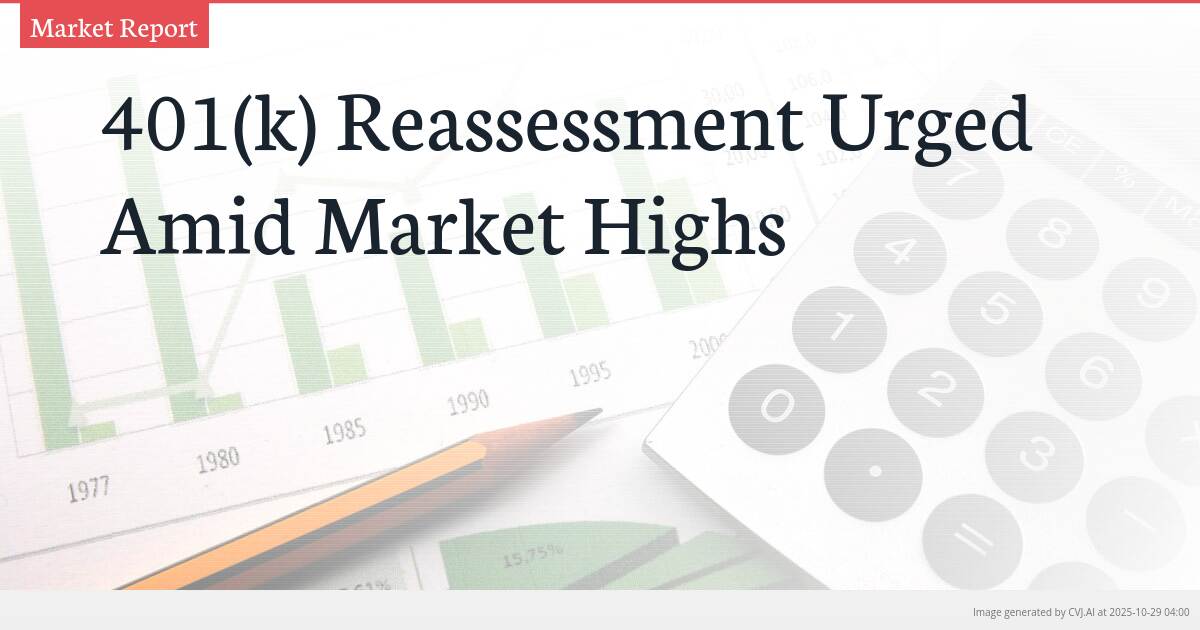This summary text is fully AI-generated and may therefore contain errors or be incomplete.
Introduction
With U.S. stock markets reaching new heights, financial professionals are urging 401(k) investors to conduct portfolio reassessments. While current conditions favor most retirement accounts, experts warn against complacency during periods of market strength. This presents an ideal opportunity for investors to evaluate their risk exposure and ensure their retirement savings are properly positioned for both continued growth and potential market volatility.
Key Points
- Wall Street analysts predict continued U.S. stock market growth despite inherent correction risks
- High market prices provide ideal conditions for retirement portfolio reassessment and rebalancing
- Investors cautioned against complacency and advised to consciously manage 401(k) risk exposure rather than relying on autopilot
The Current Market Landscape
Wall Street professionals are forecasting that the U.S. stock market will continue its upward trajectory, creating an environment where nearly everything in typical 401(k) portfolios appears to be performing well. This widespread market strength has created a situation where retirement accounts across the country are showing positive returns, giving investors the luxury of reviewing their positions from a position of strength rather than reacting to market distress. The current market conditions represent what many consider an optimal moment for strategic financial planning.
However, this period of market prosperity comes with inherent risks that investors must acknowledge. The threat of a sharp market drop remains ever-present, as it always does in equity markets. This dual reality—current market highs coupled with the persistent possibility of correction—creates a critical juncture for retirement investors who need to balance optimism with prudent risk management in their 401(k) allocations.
The Dangers of Autopilot Investing
One of the primary concerns financial professionals are highlighting is the danger of leaving 401(k) accounts on autopilot during extended market upswings. When portfolios are consistently performing well, investors often become complacent, assuming their current allocation strategy will continue to deliver optimal results indefinitely. This passive approach can lead to unintended risk exposure as market conditions evolve and personal financial circumstances change.
The warning from Wall Street experts is clear: don’t get lulled into maintaining your 401(k) settings without conscious evaluation. While automated investment strategies can be effective when intentionally chosen, blindly maintaining the status quo during market highs can leave investors vulnerable to sudden downturns. The current environment demands active engagement with retirement portfolios rather than passive acceptance of whatever allocation has been in place.
Strategic Portfolio Reassessment
High market prices provide an ideal backdrop for 401(k) reassessment because investors can make strategic adjustments from a position of strength. This involves carefully examining whether your portfolio has become overconcentrated in certain sectors or asset classes that have performed particularly well during the recent market run. The goal is to ensure your retirement savings aren’t stuffed with too much risk relative to your time horizon and financial objectives.
This strategic review process should include evaluating whether your current 401(k) allocation still aligns with your retirement timeline and risk tolerance. Investors approaching retirement may need to consider reducing equity exposure to protect accumulated gains, while those with longer time horizons might maintain more aggressive positions but still benefit from rebalancing to maintain their target asset allocation. The key is making conscious decisions rather than allowing market momentum to dictate your portfolio’s risk profile.
Financial professionals emphasize that this isn’t about timing the market or making drastic changes based on short-term predictions. Instead, it’s about using favorable market conditions to conduct a thorough gut check of your retirement strategy. By proactively managing risk exposure during market highs, investors can better position their 401(k) accounts to weather potential volatility while still participating in continued market growth.
📎 Read the original article on kob.com

